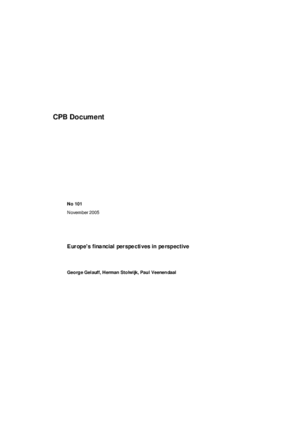Europe's financial perspectives in perspective
A healthy European budget asks for reforms
Yet, from an economic perspective the subsidiarity principle is much more important: Should the funds be allocated by the Union or by the individual member states? From that angle, a number of fundamental reform options of European agricultural policy and structural actions (support to lagging regions) suggest themselves. These reform options may roughly halve the EU budget. In addition, they happen to bring the net payment positions of member states closer together.
Researchers George Gelauff, Herman Stolwijk and Paul Veenendaal of CPB Netherlands Bureau of Economic Policy Analysis (CPB) draw these conclusions in CPB Discussion Paper 101, 'Europe's financial perspectives in perspective', which is published today.
European integration: low costs, high benefits
European citizens benefit from European integration at relatively moderate cost. Studies show that the average resident in the EU earns 10% more than he or she would have done without European integration. In addition, policy coordination in the EU prevents waste through overlapping policy efforts or discordant interactions between governments (for instance, excessive competition between governments to attract companies). The budget of the EU comprises about 1% of gross national income (GNI) of the member states. Costs of implementation of EU policies mainly consist of expenditure for the common agricultural policy and the structural actions (support to lagging regions). The costs of the European institutions, such as the European Commission and the European Parliament, only comprise 0.05% of member states' GNI, i.e. 5% of the EU budget.
Only EU policy if gains exceed those of national policies
Still, EU expenditure can further be reduced, if the subsidiarity principle is followed more strictly. According to this principle, EU policies are only warranted if they bring about additional gains over policies implemented at the national or regional level. Currently, the main part of the EU budget is spent on agriculture and structural actions. Historically, this can easily be understood. However, conditions have changed and, from a subsidiarity perspective, a fundamental reform of the budget rules seems appropriate.
A rough calculation shows that implementing these reforms might nearly halve the European budget. At the same time there would be no reason to hold on to the budget rebate that all member states pay to the UK. By consequence, the net payment positions of member states would happen to be closer together as well.
Less funding for EU agricultural policy
For the EU's agricultural policy, the criterion of common European interest is much less relevant than in the past. Over the past twenty years, the EU agricultural policy has changed considerably. The emphasis has increasingly shifted from guaranteeing minimum prices to providing support decoupled from production. In the long term, these direct payments can only be justified if the recipients produce socially valuable non-market goods or services. The decoupled payments, which at the moment are linked mainly to farm size and historical production, should be a direct reward for an explicitly delivered "service", such as maintaining the landscape or the preservation of quality-of-life in rural areas. Because the benefits of these services primarily accrue to national or regional residents, direct funding by the member states instead of the Union (financial renationalisation) of a substantial part of the outlays on agriculture seems reasonable.
Support to regions in rich member states unnecessary and not effective
When structural actions benefit only the poor member states and no longer the rich member states, effective redistribution in the EU is improved. Currently, also regions in rich member states benefit from EU structural actions. However, rich member states have sufficient means to support their lagging regions. Moreover, it is likely that national governments have better information on where and how to spend support effectively than the EU. They also have a stronger incentive to spend the means effectively. Hence, structural support can better be put at the disposal of the governments of the poor member states, which subsequently decide on the projects they want to spend it on.
Read also the accompanying press release.
Yet, from an economic perspective the subsidiarity principle is much more important: Should the funds be allocated by the Union or by the individual member states? From that angle, a number of fundamental reforms of European agricultural policy and structural actions (support to lagging regions) suggest themselves. These reform options may roughly halve the EU budget. In addition they happen to bring the net payment positions of member states closer together.
